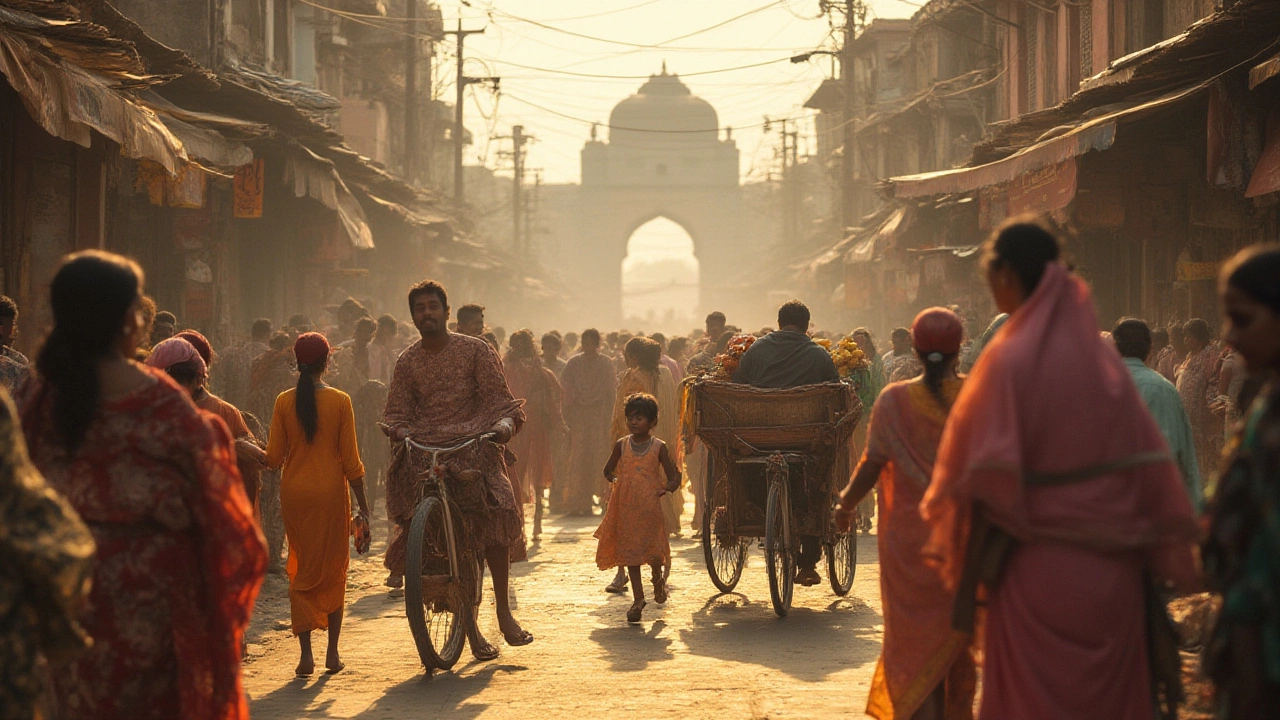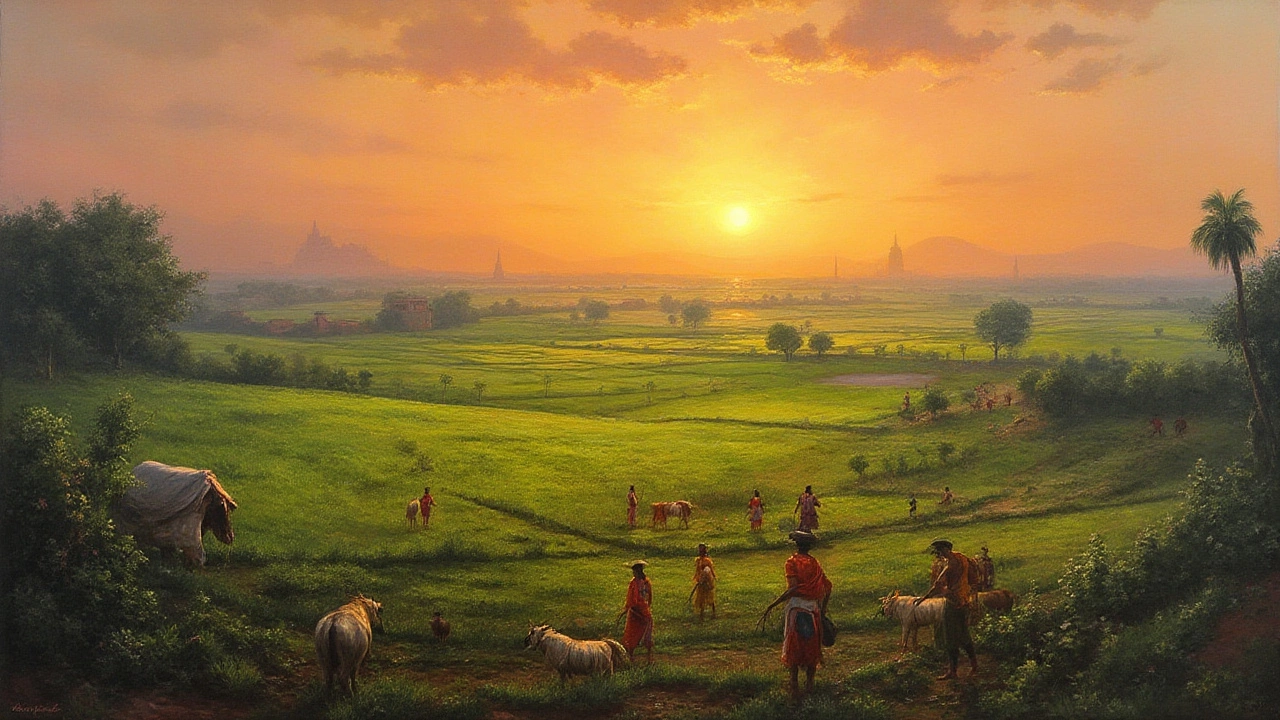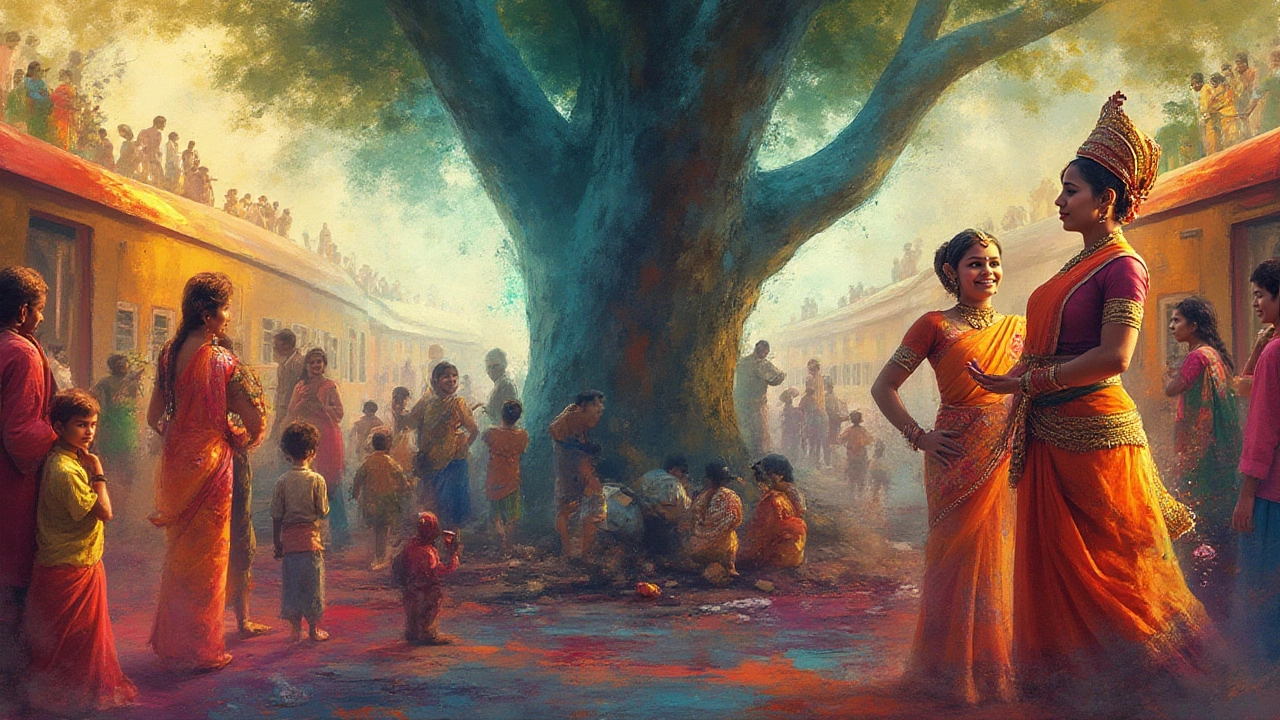Three Words That Best Describe India: Diversity, Resilience, and Spirit
 Jul, 14 2025
Jul, 14 2025
If you ask ten people to describe India in three words, you’ll probably get ten different answers. Indians are used to this confusion. This country messes with every kind of expectation. In the outside world, foreigners try to fit India into neat little boxes: poor or rich, ancient or modern, chaotic or calm. Truth is, India laughs at those labels. Want to shrink it into three words? Good luck—but I’ll try. Get ready for a ride through India’s wild diversity, real resilience, and unstoppable spirit.
Diversity: One Nation, Endless Worlds
Step off a plane in Delhi and the first thing you notice is not the famous smog, but the noise—a mashup of a dozen languages, chai-sellers calling out, the roar of motorbikes. In India, diversity isn’t just about how people talk. It’s about who they are, what they eat, how they pray, even how they argue. Delhi alone has immigrants from every Indian state and even from Afghanistan, Tibet, and Africa. Drive 100 kilometers in any direction, and you’ll find a different language, a new way to dress, and fresh stories in the air.
Think about languages—India recognizes 22 official languages, but everyday conversation happens in over 1900 different tongues. The language on the street in Chennai (Tamil) sounds nothing like what a shopkeeper speaks in Lucknow (Hindi-Urdu mix). According to the 2011 Census, the state of Nagaland alone counts 17 major languages and 36 dialects. India’s diversity is wild but not just in languages. Food, for example: biryani means one thing in Hyderabad, something else entirely in Kolkata. You could eat a different dish for every meal and never taste the same one twice for months.
You see this in even stranger ways. In West Bengal, the biggest festival is Durga Puja—giant clay statues, ten-day carnivals, music non-stop. But move to Kerala and you get Onam, complete with snake-boat races and a feast on banana leaves. Walk into the bustling streets of Old Delhi, and the air smells of kebabs, jalebis, and burning incense from a nearby dargah. Across the river in East Delhi, you might hit a langar at a massive Sikh gurdwara where free meals are handed out all day. The religious mix feels impossible: millions of Hindus, Muslims, Sikhs, Christians, Buddhists, Jains, even Jews and Zoroastrians—like a cosmic experiment that shouldn’t work, but does.
India’s natural diversity is a fact that stuns most first-time travelers. Think of the Himalayas—a land of snowy mountains and pine forests—then compare it to Rajasthan’s sand dunes or the tropical beaches of Goa. There are tigers in the Sundarbans, elephants in Kerala, snow leopards in Ladakh. Forget stereotypes of elephants on the streets; these animals are wild, and sometimes, so are the people.
The mix spills into politics, too. India’s democracy is one of the most vibrant and noisy around. In the 2024 national elections, over 900 million people had the right to vote, and more than 60% turned out—some walking hours to stand in line. With dozens of parties, each with their own agenda, representing big cities and tiny tribal hamlets, forming a government feels like hosting a wild wedding feast with thousands of guests who can’t agree on the menu.
If you’re traveling here, a good tip: don’t expect things to work or look the same from one state to the next. In Jaipur, dress modestly and avoid beef. In Goa, beachwear is normal, and the best dinner might be a pork vindaloo. Learn to say thank you in a few local languages: “Dhanyavaad” in Hindi, “Nandri” in Tamil, “Shukriya” in Urdu. It wins hearts everywhere.
The real magic? Indian diversity isn’t just tolerated—it’s often celebrated. At Holi, strangers spray color on each other. At Diwali, neighbors light lamps together, Christian or not. Eid brings biryani to the entire street, and Christmas means cakes shared even by families who never went to church. Here, difference is what gives daily life its flavor.
| Region | Main Language | Major Festival | Staple Food |
|---|---|---|---|
| Punjab | Punjabi | Lohri | Wheat (roti) |
| Tamil Nadu | Tamil | Pongal | Rice (idli, dosa) |
| West Bengal | Bengali | Durga Puja | Fish, rice |
| Kerala | Malayalam | Onam | Rice, coconut-based dishes |
| Gujarat | Gujarati | Navratri | Dhokla, thepla |
Resilience: Thriving Against All Odds
India is a country that never got an easy deal. Split and stitched together from 565 princely states at Independence in 1947, battered by partition, marches, famines, and wars. Anyone would expect a mess, maybe even a collapse. But resilience—that unbeatable stubbornness—is wired into Indian DNA.
Every day, you see stories that would make your head spin. In Mumbai, a city of 22 million, the early-morning dabbawalas deliver home-cooked tiffins—over 200,000 lunches—without GPS, mostly on bicycles and trains, and with a legendary error rate of less than 1 in 16 million deliveries (studied even by Harvard). In Delhi, when record-breaking heatwaves hit—49°C in June 2024—people keep working, kids still play cricket in the evening, and chai-wallahs drag their stalls to shaded corners. Life doesn’t stop.
Think about small farmers in Maharashtra. The monsoons have grown unpredictable due to climate change, but farmers constantly invent new rainwater harvest techniques or plant climate-resilient seeds. NGOs like Barefoot College in Rajasthan train women as solar engineers—even grandmothers who never went to school. Now they bring solar lamps to remote villages, lighting up lives for the very first time.
Pandemics, too, have become a test of grit. When COVID-19 hit, the sheer speed of India’s vaccination drive shocked many. Over 2 billion vaccine doses were administered by mid-2023, with teenage volunteers and retired doctors running pop-up camps in urban slums and distant villages. Delivery companies, big and small, switched gears to provide oxygen cylinders and pulse oximeters instead of pizzas and groceries. Auto drivers gave free rides to hospitals, risking their own health. This adaptability repeats every time disaster strikes—from floods in Assam to earthquakes in Gujarat—ordinary Indians step up with food drives, shelter, and donations, no waiting for politicians to act first.
The working class has built entire cities from scratch. Gurgaon, today packed with skyscrapers and tech offices, was mostly farmland 30 years ago. Migrant workers come from Bihar, Odisha, West Bengal—they build houses they’ll probably never live in. In most Indian families, parents save every bit to send their kids to school, even if it means skipping a meal themselves. And education pays back: the Indian diaspora—over 18 million strong—is running companies, universities, and research labs from Silicon Valley to Sydney.
Traffic jams or red tape don’t faze anyone; people adjust, invent, hustle. The jugaad mindset rules here—make it work with whatever you have on hand. Your autorickshaw breaks down? The driver will fix it with a bit of wire and a spare shoe lace, then blast Bollywood music and speed off, unfazed. This can-do attitude shapes everything—startups, street food, pop culture.
Yes, poverty is real, as are daily struggles: over 10% of the population lives below the poverty line as of 2024, and the gap between rich and poor is stark. Yet, where some countries choke, Indians find ways around obstacles. Communities pool money for a neighbor’s surgery, rickshaw drivers form WhatsApp groups to squash ride-hailing scams, and young people use social media to crowdfund school fees, medical bills, and wedding costs.
If you land here, don’t expect comfort zones. The resilience you see isn’t about easy optimism—it’s raw, practical courage. Try matching the rhythm of the morning crowds at Delhi’s Chandni Chowk, where thousands of vendors set up shop while dodging cows, traffic, and municipal raids. Business shrugs off blackouts, strikes, and pandemic lockdowns. If a street vendor loses his spot, he simply relocates to another lane the next day.
Want to know the real tip for surviving in India? Keep moving, keep adapting—there’s always another way forward. If you can’t plan, improvise. Missed your train? There’ll be another one in ten minutes. Dropped your phone in the metro? A kind stranger might just chase you down to return it. No matter what happens, India never stops for long.
| Year | Natural Disaster | Lives Impacted | Relief Response (Days) |
|---|---|---|---|
| 2001 | Gujarat Earthquake | 8 million | First camps set up within 2 days |
| 2014 | Kashmir Floods | 2.5 million | Food & shelters in 48 hours |
| 2020 | COVID-19 Wave | Over 100 million affected | 2 billion vaccine doses by 2023 |
| 2023 | Assam Floods | 6 million | Food camps, donation drives same week |

Spirit: Finding Joy and Meaning Everywhere
No matter how tired or frustrated you get in India, you’re going to run into the country’s spirit—a combination of energy, humor, and a hunger for life that doesn’t shut up easily. You see it in the chai breaks, cricket games happening wherever space allows, and the constant parade of weddings, festivals, and protests. Indians seem addicted to noise, song, and color. Get on a train and watch—it becomes a singing, laughing, sharing picnic, even if the journey lasts 36 hours.
The ancient meets the brand new in the same breath. In Varanasi, priests chant Sanskrit mantras at sunrise on the Ganga River, but teenagers skate past temples listening to Punjabi rap. In tech hubs like Bengaluru, coders break for dosas with coconut chutney before grinding away at code that runs some of the world’s biggest apps. This old-new blend is everywhere—a rickshaw driver might recite shlokas, then hand you his UPI QR code for payment. India balances the mystical and the modern without batting an eye.
Music and movies are everywhere. Bollywood doesn’t just produce slick blockbusters: regional cinema, from Kerala’s thrillers to Marathi indie films, is winning international awards. Street musicians play tabla, sitar, or even a plastic bucket if that’s all they have. Weddings blur the line between professional singers and uncles with endless enthusiasm. Holi, Diwali, Eid, Gurpurab—everything becomes an excuse for singing, dancing, and sharing food. If you’re in town during Ganesh Chaturthi, prepare for street parties where total strangers may drag you into a dance, handing you a sweet if you’re a foreigner and teasing your moves if you’re Indian.
Crowds don’t mean anonymity. Most Indians live in extended families; even in cramped metro cities, four generations might share a flat. This togetherness is a lifeline—at dinner, eight people may argue at once, but if trouble hits, they stand up for each other, no questions asked. Community ties are strong, with neighbors who’ll share onion pakoras or help fix a leaky tap. Social life pulses at tea stalls, local parks, and Instagram memes. If something makes the news, expect it to be fiercely debated with friends, family, or complete strangers in a queue.
Indian spirituality isn’t limited to big temples and high priests. People light lamps at roadside shrines, join dawn yoga in public parks, or meditate at home—not always with solemn faces. In recent years, mindfulness apps in Hindi, Tamil, and Bengali have exploded in popularity, as tech-savvy millennials search for balance amid cities that never sleep. If you’re feeling lost, join a satsang, listen to qawwali at Nizamuddin Dargah, or just sit by the Yamuna at sunset. You’ll find peace, no matter what your faith.
There’s another side too: the habit of finding humor in chaos. Nothing is off-limits for jokes—politicians, marriage, power cuts, even serious news. Social media, especially WhatsApp, turns every big event into a stream of memes, puns, and light-hearted debates. The spirit of “chalta hai” (it’ll be fine) drives Indians through rough patches, but don’t mistake it for laziness. It’s a way of saying: we’re tougher than our troubles.
Kids play cricket in narrow alleys filled with washing lines; grandmothers gossip over herbal chai on balconies. There’s a festival, a market, or a protest around every corner, with crowds that rarely move in a straight line. If you’re a visitor, embrace the madness. Practice saying “thik hai” (it’s okay) and hang on for the ride.
| Festival | States Celebrated | Average People Attending (Millions) | Months |
|---|---|---|---|
| Diwali | All over India | Over 400 | Oct-Nov |
| Holi | North, West, Central | 300+ | Feb-Mar |
| Durga Puja | West Bengal, East India | 70+ | Sept-Oct |
| Onam | Kerala | 25+ | Aug-Sept |
| Eid | All states | 160+ | Varies (Islamic Calendar) |
Surprising Faces of Everyday India
What catches people off guard about India is how “normal” life can look one moment, only to flip upside-down the next. In cities, life races—from five-star hotels to informal slums beside gleaming malls. But take the metro, and you’ll find everyone on the same train—bankers beside students, office-goers sharing phone chargers with gig workers. India’s middle class is now over 300 million strong, and millions more are trying to join them. You’ll see signs of ambition everywhere, from tuition ads plastered on rickshaws to young couples arguing about EMIs over street food.
Education is a national obsession. Every family wants their kids to become doctors, engineers, or IAS officers. Coaching classes for competitive exams are legendary; “JEE” and “NEET” mean stress for teenagers, entire businesses for tutors, and dinner table drama. Yet, the same kids learn to juggle homework and chores, family events, and cricket matches. The pressure is high, but so is the drive to keep going.
Technology is changing everything. Fast internet is everywhere, even in remote villages, thanks to cheap mobile data (India has some of the world’s lowest rates—less than ₹20 per gigabyte). Shopkeepers announce new deals on WhatsApp, farmers use government apps for crop rates, and street food sellers accept payments with a tap of your phone. In Bengaluru, it’s not uncommon for an auto-wallah to discuss cryptocurrency, or for rural artisans to livestream their crafts.
Gender roles are also shifting. While patriarchy is real, young women are breaking barriers. Nearly 50% of Indian startups have at least one woman as founder or co-founder. The 2025 Women’s Indian Premier League (cricket) has inspired a new generation—girls in small towns dream of sports scholarships. In Bollywood, women-centric films are racking up box office numbers like never before. These changes aren’t overnight, but they’re picking up speed.
Don’t think rural India is stuck in time. Solar panels dot distant villages, start-ups are building cold storages for farmers using AI, and online education is reaching tribal communities for the first time. Yes, there are still problems—like pollution, unsafe roads, and corruption—but there’s also a loud demand for better. People protest, share outrage (and solutions) on social media, and refuse to be silent anymore.
There’s this weird but beautiful Indian habit—making strangers into friends. Got lost in Mumbai? Someone will walk you to your destination. Missed the bus in Manali? Someone will offer a ride. Don’t be surprised if a neighbor invites you for chai and insists on feeding you home-cooked food even if you’re just passing by. Hospitality isn’t a ritual—it’s in the bloodstream.
The wildest thing? No two days feel the same. Rains can turn a highway into a river, a political protest can snarl traffic for hours, or news of a favorite celebrity brings the street to a halt. But the next day, life moves forward like nothing happened—same old smiles, same rush, same hope.

Tips for Exploring and Understanding the Real India
If you want to truly “get” India, throw out whatever guidebook rules you’ve read. This isn’t a museum; it’s a living, changing giant with too many layers to count. Walk slow, taste everything, and ask strangers for help—they probably give better advice than Google Maps. Never dismiss something as “normal” or “typical.” What’s ordinary one day could be an epic story the next.
- Break your routine: Pick a random local market, not a tourist hotspot. Bargain for a silk scarf, eat street samosas, sip sugarcane juice, or buy flowers from a temple vendor.
- Learn the basics: Yes, English gets you by in cities, but learn a few local words for “thank you,” “how much?,” “good food,” and “no problem.” You’ll see doors open.
- Take the chaos with humor: Trains will be late, WiFi might crash, power cuts will happen. Smile, try again, and let life surprise you.
- Honor local customs: Cover your head in some temples, leave your shoes outside homes, and avoid public displays of affection in smaller towns. In India, a little respect goes a long way.
- Dive into festivals: If you’re here during Holi or Diwali, join in—but wear clothes you can ruin. You may end up in a stranger’s house for a meal. That’s normal.
- Ask questions: Most Indians love explaining their food, festivals, history—sometimes with wild myths thrown in for fun. Enjoy the stories, and ask for more.
- Accept help: Lost your way? Someone will probably rescue you. Don’t be shy—people love helping outsiders, and you’ll get a real taste of Indian generosity.
- Embrace contradictions: India is rich and poor, old and brand new, polite one moment and pushy the next. Don’t expect anything to fit a simple mold.
- Document your experiences: Keep a journal, take photos, share stories—India is full of characters and moments you’ll want to remember.
- Be open-minded: If you arrive ready to be surprised, you’ll love it here. Nothing stays the same, and that’s half the fun.
Stop trying to solve India like a riddle. Instead, live it, taste its dishes, ride its trains, talk to everyone. You’ll leave with more questions than answers—and that’s the best souvenir you can get.